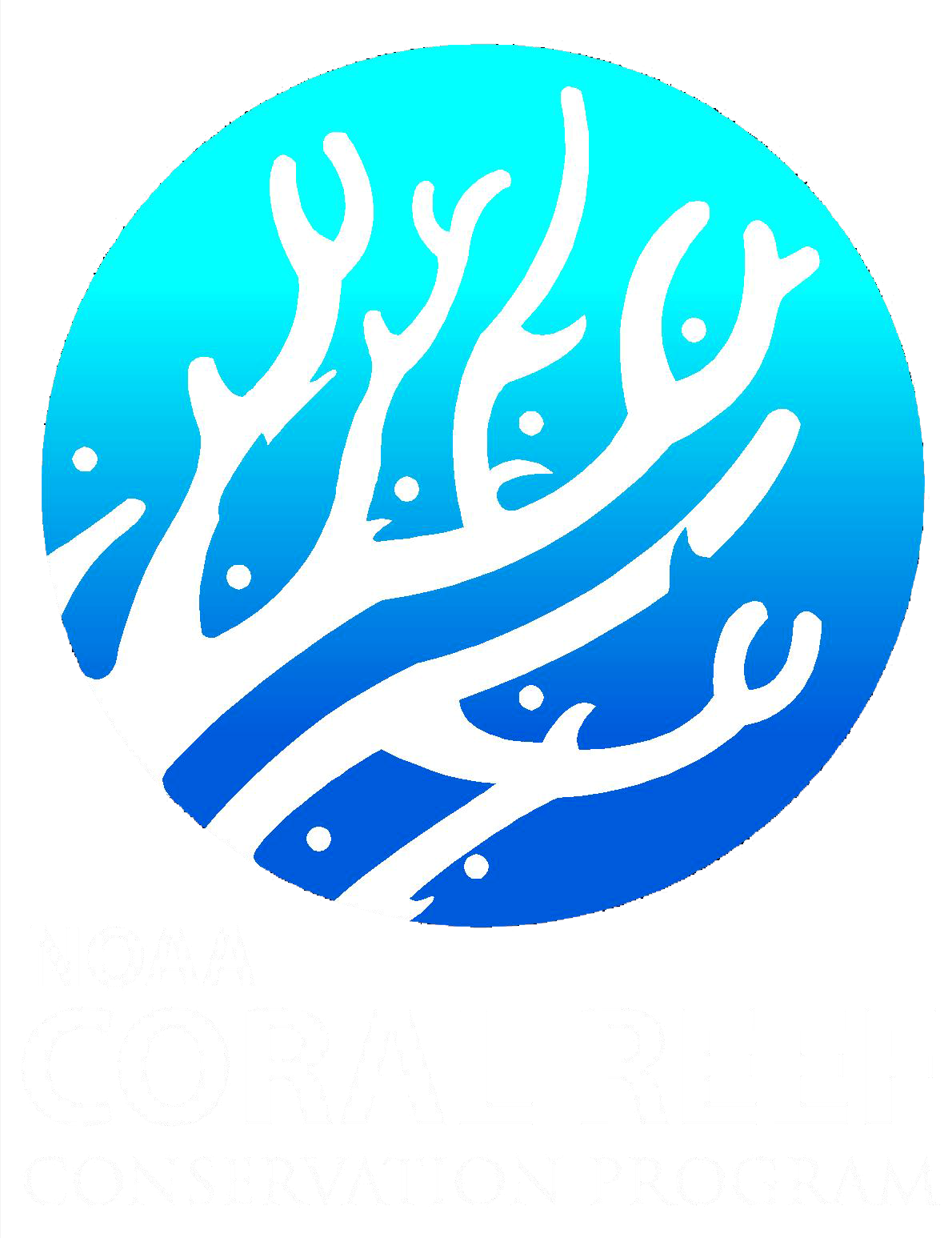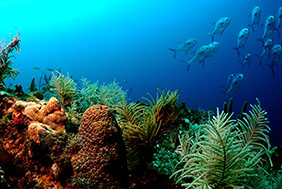The Coral Program's Watershed Management Activities
An important component of NOAA's Coral Program efforts to protect coral
reef ecosystems from land based sources of pollution has been
the development of watershed management plans and conservation
action plans. Watershed management and conservation action plans outline a comprehensive set of actions and
an overall management strategy for improving and protecting each jurisdiction's
priority watershed sites from nonpoint and point sources of pollution.
By providing technical assistance to the jurisdictions, fostering institutional
partnerships and leveraging financial resources, NOAA and our partners
are supporting the management of land-based activities to effectively
address the impacts of land-based sources of pollution.
Green Infrastructure for Coral Conservation
Green infrastructure, or the use of natural or permeable infrastructure to reduce and treat stormwater, is one way to reduce land-based sources of pollution from negatively impacting nearshore coral reefs habitats.
Green Infrastructure for Coral Conservation
Unpaved Road Standards for Caribbean and Pacific Islands
Stormwater management in Pacific and Caribbean Islands: A practitioner's guide to implementing LID
U.S. Coral Reef Task Force’s Watershed Partnership Initiative
In 2009, the U.S. Coral Reef Task Force (USCRTF) developed a Watershed Partnership Initiative to focus the capabilities and capacities of the USCRTF agencies and the U.S. coral reef jurisdictions to reduce land-based sources of pollution from entering into coastal coral reef areas. The following products have been developed to advance this initiative:
- USCRTF Watershed Partnership Initiative Priority Ecosystem
Indicators
This document provides coastal managers, coral reef managers, and watershed coordinators faced with modest budgets and technical expertise with a suite of recommended ecological indicators and measurements to include in their watershed-specific monitoring plans to help determine the efficacy and evaluate the success of management efforts to reduce land-based sources of pollution.
- USCRTF Watershed Partnership Initiative Programmatic Checklist
A user-friendly checklist is now available to help managers and watershed coordinators identify programmatic needs for the successful implementation of a ridge to reef watershed management plan.
- USCRTF Watershed Partnership Initiative Strategy
This document is the overarching strategy for the U.S. Coral Reef Task Force Watershed Partnership Initiative. This strategy includes a description of the USCRTF Watershed Working Group, the group’s goals, objectives, and actions. Additionally, this strategy provides guidelines for the implementation and graduation of the priority watersheds.
- USCRTF Watershed Partnership Initiative Sustainability Plan Template
This document provides coastal managers, coral reef managers, and watershed coordinators with a template to determine how ongoing operational expenses (support for a watershed coordinator, water quality and coral reef monitoring, maintenance of best management practices) will be sustained long-term to accomplish the goals and objectives outlined in the watershed management plan.
- USCRTF Watershed Partnership Initiative Guided Worksheets for Building Social and Community Engagement Associated with Implementing Priority Watershed Projects
These guided worksheets were developed to support the social and community engagement aspects of the Watershed Partnership Initiative. Stakeholder involvement is essential for successfully transitioning long-term watershed management activities and ongoing monitoring from federally funded startup activities to local partners. These worksheets guide watershed coordinators through a process to identify stakeholder groups for their sites and determine appropriate levels of engagement when implementing priority projects. They also provide a framework for linking stakeholder engagement to objectives which will increase the likelihood of long-term success and sustainability.
Puerto Rico
Puerto Rico has four priority sites: Cabo Rojo, Culebra, Guánica
Bay, and the Northeast Reserves. These four sites were selected by a
working group comprised of coral reef managers in Puerto Rico. Guánica
Bay has been selected by the U.S. Coral Reef Task Force as a priority
watershed partnership initiative site. Current project partners include:
National Oceanic and Atmospheric Administration, USDA's Natural Resources
Conservation Service and Forest Service, U.S. Fish and Wildlife Service,
U.S. Geological Survey, U.S. Environmental Protection Agency, PR Department
of Natural and Environmental Resources, PR Aqueduct and Sewer Authority,
PR Environmental Quality Board, Puerto Rico Planning Board, and National
Fish and Wildlife Foundation.
Guánica Bay
Watershed Management Plan (WMP)
Implemented Recommendations
Related Resources
Culebra
Watershed Management Plan
Implemented Recommendations
Related Resources
Northeast Reserves
Watershed Management Plan
Related Resources
Cabo Rojo
Watershed Management Plan
Implemented Recommendations
Search for Related Information
U.S. Virgin Islands (USVI)
USVI has four priority areas: St. Croix East End Marine Park, St. Thomas
East End Reserve, Fish Bay, and Coral Bay. These four sites were selected
by a working group comprised of coral reef managers in the USVI. Current
project partners include: National Oceanic and Atmospheric Administration,
USDA Natural Resources Conservation Service, U.S. Environmental Protection
Agency, National Park Service, U.S. Geological Survey, USVI Department
of Planning and Natural Resources, the University of the Virgin Islands,
The Nature Conservancy, Coral Bay Community Council, St. Croix Environmental
Association, Virgin Islands Resource Conservation and Development Council,
and the Island Resources Foundation.
St. Croix East End Marine Park
Watershed Management Plan
Implemented Recommendations
Related Resources
St. Thomas East End Reserve
Watershed Management Plan
Related Resources
Fish Bay
Watershed Management Plan
Implemented Recommendations
Related Resources
Coral Bay
Watershed Management Plan
Implemented Recommendations
Related Resources
Search for Related Information
Florida
The Florida Reef Tract was originally identified as one priority region
for the state. This course-scale delineation of the southeast Florida
region as one large priority area made it difficult to implement management
activities on the project scale to address impacts of LBSP on the reef
tract. Thus the Coral Reef Conservation Program partnered with a number
of federal, state, and county agencies to delineate this area into more
manageable subwatershed units. The subwatershed scale planning process
identified that the nine inlet contributing areas: St. Lucie Inlet, Jupiter
Inlet, Lake Worth Inlet, South Lake Worth (Boynton) Inlet, Boca Raton
Inlet, Hillsboro Inlet, Port Everglades, Baker's Haulover Inlet and Government
Cut in Miami are analogous to subwatersheds. Current project partners
include: National Oceanic and Atmospheric Administration, U.S. Environmental
Protection Agency, USDA Natural Resources Conservation Service, National
Park Service in Biscayne, Everglades and Dry Tortugas National Parks,
Florida Keys National Marine Sanctuary, U.S. Fish and Wildlife Service
Key National Wildlife Refuge, the Florida Department of Environmental
Protection, South Florida Water Management District, Florida's Fish and
Wildlife Conservation Commission, Florida International University, NOVA
Southeastern University, Palm Beach County's Environmental Resources
Management, Miami-Dade County's Department of Environmental Resources
Management, Broward County's Environmental Protection Department, John
Pennekamp State Park, John U. Lloyd State Park, and the St. Lucie Inlet
State Park.
Watershed Management Plan
Related Resources
Search for Related Information
Hawaii
Hawai'i has two priority sites: West Maui; and Pelekane
Bay/Puako-Anaeho'omalu Bay, Hawai'i Island. These sites were selected
by a working group of coral reef managers in Hawai'i. Wahikuli- Honokōwai,
Maui has been selected by the U.S. Coral Reef Task Force as a priority
watershed partnership initiative site. Current project partners include:
National Oceanic and Atmospheric Administration, U.S. Environmental Protection
Agency, U.S. Geological Survey, USDA Natural Resources Conservation Service,
U.S. Fish and Wildlife Service, U.S. Army Corps of Engineers, Hawai'i
Division of Aquatic Resources, Hawai'i State Department of Health, Hawai'i
Coastal Zone Management Program, Maui County, Hawai'i County, Mauna Kea
Soil & Water Conservation District, Mauna Kea Watershed Partnership,
University of Hawai'i Sea Grant, The Nature Conservancy, National Fish
and Wildlife Foundation, West Maui Ridge to Reef Working Group, Coral
Reef Alliance, Haereticus Marine Labs, Maui Nui Marine Resources Council,
Kohala Coast Resort Association, Kohala Center, Mauna Lani Sea Adventures,
Kalahuipua'a Fishpond, and Ala Kahakai National Historic Trail. In addition
there are four existing LBSP LAS watersheds (Maunalua Bay, Oahu; Honolua
Bay, Maui; Hanalei, Kaua'i; and Kawela - Kamalo, Moloka'i) where the
LBSP LAS is providing limited technical and financial support to complete
on-going projects.
West Maui
Watershed Management Plan
Implemented Recommendations
Related Resources
Pelekane Bay/Puako-Anaeho'omalu Bay, Hawai'i
Watershed Management Plan
Implemented Recommendations
Search for Related Information
Commonwealth of the Northern Mariana Islands (CNMI)
CNMI has three priority sites: LaoLao Bay and Garapan on Saipan, and
Talakhaya, Rota. These three priority sites were selected by a working
group of coral reef managers in CNMI. Current project partners include:
National Oceanic and Atmospheric Administration, USDA Natural Resources
Conservation Service, U.S. Department of Interior, CNMI Department of
Land and Natural Resources, CNMI Division of Environmental Quality, CNMI
Coastal Resource Management Office, CNMI Division of Fish and Wildlife,
Rota Soil and Water Conservation District, Saipan Mayor's Office, The
Nature Conservancy, Rare Micronesia, Mariana Islands Nature Alliance,
Pacific Marine Resources Institute, and Rota Public School.
Achugao - Saipan
Watershed Management Plan
LaoLao Bay
Watershed Management Plan
Related Resources
Garapan - Saipan
Watershed Management Plan
Implemented Recommendations
- Garapan, CNMI Rain Garden Installation
Related Resources
Talakhaya - Rota
Watershed Management Plan
Implemented Recommendations
Related Resources
Search for Related Information
Guam
Guam has three priority sites: Piti/Asan, Manell/Geus, and a third in
northern Guam to be determined. These priority sites were selected by
a working group of coral reef managers in Guam. Current project partners
include: National Oceanic and Atmospheric Administration, USDA Natural
Resources Conservation Service, National Park Service, U.S. Geological
Survey, Guam Coastal Management Program, Guam Environmental Protection
Agency, Guam Department of Agriculture Division of Aquatic Wildlife Resources
and Division of Forestry, Southern Soil and Water Conservation District,
Piti Mayor's Office, Asan Mayor's Office, Merizo Mayor's Office, Mariana's
Resource Conservation and Development Council, The Nature Conservancy,
Guam Environmental Alliance, Guam Environmental Education Partners Incorporated,
Ayuda Foundation, University of Guam, Guam Community College, and George
Washington High School.
Piti/Asan
Watershed Management Plan
Implemented Recommendations
- Piti Asan, Guam Rain Garden Installation
Manell/Geus
Watershed Management Plan
Implemented Recommendations
Related Resources
Related Resources
- Guam Erosion and Sediment Control
Search for Related Information
American Samoa
American Samoa has four priority sites: Aua, Faga'alu, Nu'uli and Vatia. These priority sites were selected by a working group of coral reef managers in American Samoa. In 2012, Faga'alu was endorsed by the U.S. Coral Reef Task Force as a priority Watershed Partnership Initiative site. The U.S. Coral Reef Task Force developed the Watershed Partnership Initiative to facilitate interdisciplinary partnerships with federal, state/territory, and local entities to mitigate pollution from priority watersheds adjacent to valuable coral reef resources. Following 10 years of partnership implementing best practices, Faga'alu watershed graduated in 2022 after demonstrating ecological improvement and establishing sufficient local capacity to monitor and manage future land-based sources of pollution issues. Current project partners include: National Oceanic and Atmospheric Administration, USDA Natural Resources Conservation Service, U.S. Forest Service, U.S. Department of Interior Office of Insular Affairs, National Park Service, U.S. Environmental Protection Agency, U.S. Geological Survey, AS Department of Commerce Coastal Management Program, AS Environmental Protection Agency, AS Department of Marine and Wildlife Resources, American Samoa Power Authority, The Nature Conservancy, National Fish and Wildlife Foundation, AS Community College-Land Grant Office, Fagatele Bay National Marine Sanctuary, National Park of American Samoa, Le Tausagi, Faga'alu Village.
Aua
Watershed Management Plan
Faga'alu
Watershed Management Plan
Implemented Recommendations
Related Resources
Search for Related Information


